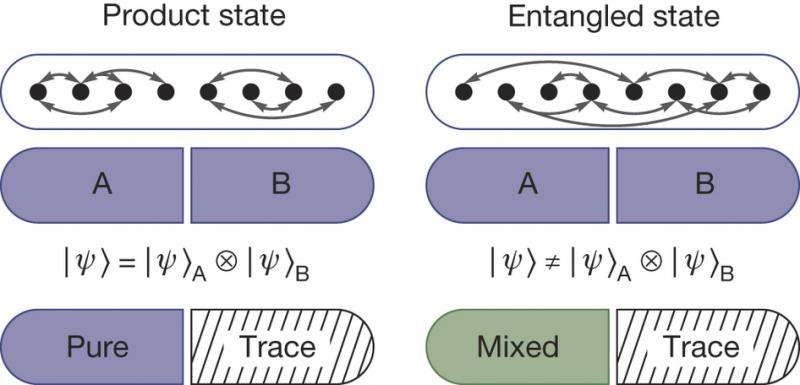December 3, 2015 report
A way to study entanglement entropy between multi-body systems

(Phys.org)—A team of researchers at Harvard University has developed a way to measure entanglement entropy in many-body systems. In their paper published in the journal Nature, the team describes the technique they used and why they believe their findings have set the stage for using entanglement to conduct future studies of many-body systems. Steven Rolston with the University of Maryland offers a News & Views piece on the research done by the team and explains why such work is important in understanding non-equilibrium systems.
Entanglement is, of course, a sometimes perplexing aspect of quantum mechanics where two separated particles share the same state—what happens to one, happens to the other, including changes made by simply measuring them. As strange as this aspect is, scientists have over the past several years come to better understand, measure and even cause it to come about on demand. But, as Rolston points out, the same cannot be said for systems where there are more than two particles involved, and that is where the researchers with this new effort focused their attention.
To learn more, they came up with a way to measure entanglement entropy, which is a measure of the seeming randomness that comes about by simply observing just a portion of an entangled system. They used lasers to create an optical lattice that caused the creation of four individual compartments in one system where each compartment held just one atom. But they created the lattice in such a way as to allow for controlling the depth of the compartments, which when set low enough allowed particles to tunnel to other compartments and thus "feel" the presence of the other particles. The arrangement allowed for the creation of a many-body state. The team built two such four-compartment systems and first caused the atoms inside the systems to be identical to the atoms in the second system, and then compared just portions of each system—they note that differences they measured between different parts of the two systems when the whole remained identical could only occur if there were entanglement in the system.
The experiments conducted by the team, Rolston notes, are the first of their kind and that means that while a lot has been shown, there is a lot more that can learned by tweaking and experimenting with the approach the group used.
More information: Rajibul Islam et al. Measuring entanglement entropy in a quantum many-body system, Nature (2015). DOI: 10.1038/nature15750
Abstract
Entanglement is one of the most intriguing features of quantum mechanics. It describes non-local correlations between quantum objects, and is at the heart of quantum information sciences. Entanglement is now being studied in diverse fields ranging from condensed matter to quantum gravity. However, measuring entanglement remains a challenge. This is especially so in systems of interacting delocalized particles, for which a direct experimental measurement of spatial entanglement has been elusive. Here, we measure entanglement in such a system of itinerant particles using quantum interference of many-body twins. Making use of our single-site-resolved control of ultracold bosonic atoms in optical lattices, we prepare two identical copies of a many-body state and interfere them. This enables us to directly measure quantum purity, Rényi entanglement entropy, and mutual information. These experiments pave the way for using entanglement to characterize quantum phases and dynamics of strongly correlated many-body systems.
Journal information: Nature
© 2015 Phys.org




















